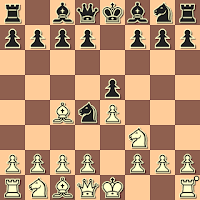 Last year I presented part of an old discussion about the Blackburne Shilling Gambit and 4.Bxf7+ at ChessGames.com. A year later the discussion continued. Here are relevant parts, with my comments.
Last year I presented part of an old discussion about the Blackburne Shilling Gambit and 4.Bxf7+ at ChessGames.com. A year later the discussion continued. Here are relevant parts, with my comments.1.e4 e5 2.Nf3 Nc6 3.Bc4 Nd4 4.Bxf7+ Kxf7 5.Nxe5+ Ke8 6.Qh5+ g6 7.Nxg6 Qf6 8.Nxh8+ Ke7 9.d3 Bh6 10.Na3 Bxc1 11.Rxc1 Qxh8 12.Qc5+ Ke8 13.Qxc7 Nf3+ 14.gxf3 Qxb2 15.Kd2 Qxa3 16.Rhg1 Qxa2 17.Qe5+ Kd8 18.Qh8 Qa5+ 19.c3 Qa2+ 20.Rc2 Qe6 21.Qxg8+ Qxg8 22.Rxg8+ Kc7 23.f4 b6 24.f5 a5 25.f6 Black resigned
TheGreatNN: Is 4.Bxf7! the best way to deal with the Blackburne Shilling Gambit? It looks pretty strong here.
acirce:
TheGreatNN: I don't think 7...hxg6 is any good because after 8.Qxh8 Nxc2+ 9.Kd1 Nxa1 10.Qxg8 white will be up material, even if black will have a bit better development (e.g. by 10...Qg5 11.Rg1 d5 12.Qxd5 Bg4+ 13.Ke1 Qxd5 14.exd5 etc.) My computer, however, came up with 5...Ke6! It then continued 6.Nd3!? Nf6 7.o-o d6 8.b4 Kf7 9.Bb2 Ne6 and it doesn't appear white has good compensation for his sacrifice. (Arasan 3.5, 9 ply.) But ...Ke6 looks like it's just welcoming disaster, so I don't know what to think.
acirce: Actually, he will be down material! After the line you give I feel that White is pretty much just lost. Better looks 8.Qxg6+ Ke7 9.Qg5+ Nf6 10.Qc5+ d6 11.Qxd4 and White has 4 pawns for a bishop but has only developed his queen.
5...Ke6 just has to be unsound but maybe 5...Ke7 is simple and working. At least this is not what you're looking for as White generally speaking.
Cyphelium:
Muhlock vs B Kostic, 1912
I think we agreed on that 4. Bxf7+ is not convincing. The analysis lead to unclear positions were white often had to defend. One amusing line we finally arrived at was 4... Kxf7 5.Nxe5+ Ke8 6.Qh5+ g6 7.Nxg6 Nf6 8.Qe5+ Ne6 9.Nxh8 d5!? 10.exd5 Bd6 11.Nf7 Kxf7 12.dxe6+ Bxe6 13.Qe2 Qg8 and black seems to have compensation?! Also, the 4...Ke7!? move was mentioned as playable. The conclusion is, I think, that 4.Bxf7+ is likely to lead to messy and unclear positions...
acirce:
Cyphelium:
Seraphina:
Granite: Bxf7+ seems to give good compensation for the piece. You get two central pawns and the black king is also trapped in the center. Moreso, you gain some time in development. So that's 2 pawns, a loose centralized king, and a gain of time for a piece - I'd say it's probably strong enough to be playable.
Rick: The "best" response to 1.e4 e5 2.Nf3 Nc6 3.Bc4 Nd4 has to be either 4.0-0, 4.Nxd4, 4.d3, 4.Nc3 or 4.c3.
4.Bxf7+!? is shocking & unexpected and can lead to exciting and/or unclear play which will favor the better-prepared combatant. The updated New Year's Database has 2,676 games with this move. White scored 56% (only 2% of the games were draws).
After 1.e4 e5 2.Nf3 Nc6 3.Bc4 Nd4 4.Bxf7+ Kxf7 5.Nxe5+ Black has two popular defenses, 5...Ke8 and 5...Ke6, and two lesser-played defenses, 5...Ke7 and 5...Kf6.
Seen most often is 5...Ke8, and after 6.Qh5+ g6 7.Nxg6, best play for both sides is 7...hxg6 8.Qxg6+ Ke7 9.Qg5+, when Black can go for the draw-by-repetition with 9...Ke8; or go for an unbalanced (but largely equal) position as acirce suggested above with 9...Nf6 10.Qc5+ d6 11.Qxd4 when White has four pawns for a piece and it is unclear if Black has an open King or open lines for development.
Seraphina's suggestion of 10...Ke8 (followed by 11...d5) instead of 10...d6 is a thoughtful one and a likely improvement, but the battle of piece vs 4 pawns remains contentious.
The problem with Cyphelium's suggested line 1.e4 e5 2.Nf3 Nc6 3.Bc4 Nd4 4.Bxf7+ Kxf7 5.Nxe5+ Ke8 6.Qh5+ g6 7.Nxg6 Nf6 8.Qe5+ Ne6 9.Nxh8 d5!? 10.exd5 Bd6 is that White can play 11.Qe2!? instead of 11.Nf7, with advantage – although the line that he gives, 11.Nf7 Kxf7 12.dxe6+ Bxe6 13.Qe2 Qg8 may be better for White, anyhow, as he is the exchange and three pawns ahead.
Risky, but not necessarily "unsound", 5...Ke6 provokes feelings wonderfully described by Seraphina. In 667 games in the Database, White scores 50% (again, draws make up only 2% of the games). Best seems to be 6.c3 Kxe5 7.cxd4+ Ke6 and Black's King runs for cover as White develops his pieces, with roughly an equal game.
After 5...Ke7 (330 games in the Database, White scores 47%, draws are 4%) I think White does best again with 6.c3, and after 6...d6 7.cxd4 dxe5 8.dxe5 Qd3!? the game is unclear, but likely balanced.
Finally, I think 5...Kf6 (78 games in the Database, White scores 60%, draws are 1%) should be met by 6.Nf3, again with an even game.
























.png)
.png)
.png)






